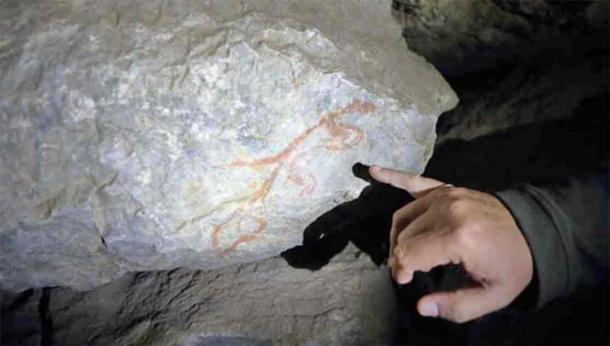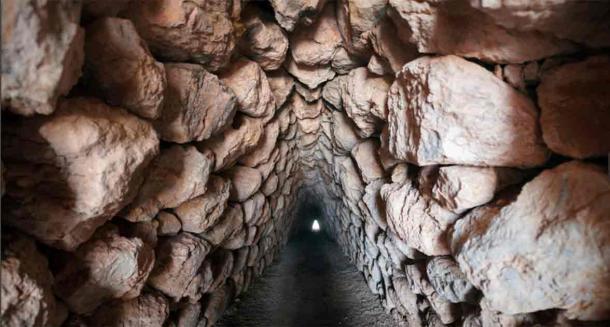Hieroglyphs at Hattusa Tunnel Reveal New Chapter in Hittite History
The discovery of painted hieroglyphs from 2022 in the Yerkapı Tunnel in Hattusa, the ancient capital of the Hittites, have now been deciphered. These Anatolian hieroglyphs have finally been unveiled to the academic community at a press conference and are believed to have opened a new chapter in Hittite studies. The 80 meter (262.4 feet) long Yerkapi Tunnel, containing at least 250 red hieroglyphs, had confirmed just last year the existence of a brand-new addition to the Anatolian Indo-European language family.
The press conference, hosted by the Culture and Promotion Consultancy of Turkey’s Embassy in Rome, was spearheaded by Professor Andreas Schachner, a leading figure in Hittite archaeology. He emphasized the profound impact of this discovery on our perception of the Hittite world, reports Arkeonews.
- Clay Tablet From 3,300-Years Ago Tells Story of the Siege and Plunder of Four Hittite Cities
- 2,800-Year-Old ‘One of a Kind’ Ivory Object Unearthed At Hattusa
A Cross-Cultural Panel: A Lost Civilization, a Language of the Common Man
At the conference, insights into the nature of the red hieroglyphs found within the Yerkapı Tunnel were shared by a panel of experts, including scholars from Turkey, Germany, and Italy who participated in the excavations. They collaborated their efforts in deciphering and analyzing these ancient symbols.
Dr. Andreas Schachner has been representing the German Archaeological Institute, serving as the Head of the Hattusa Excavation. In his address, he acknowledged the pivotal role played by Associate Professor Bülent Genç from Mardin Artuklu University Archaeology Department in the discovery of the hieroglyphs.
- Farmer Finds 3,300-year-old Rare Hittite Bracelet in Field in Turkey!
- The Royal Bloodline Of The Hittite Empire

Anatolian hieroglyphs used during the tunnel's construction offer significant insights into the Hittite period. (AA)
Schachner stated that the hieroglyphs appeared to serve as a signature, inscription, or expression of 'I did it' by the individual responsible for constructing the tunnel. He further noted that, concurrently, it was understood that in the Hittite world, Anatolian hieroglyphs, characterized by their pictorial script, were likely much more prevalent than cuneiform script.
He explained that Anatolian hieroglyphs were commonly utilized in everyday life. According to him, while cuneiform was predominantly associated with elite circles and state usage, Anatolian hieroglyphs were expected to have had various applications such as everyday communication and city navigation signs, among other things, and thereby used less by the elite.

Hatussa Yerkapi Tunnel. Bogazkale, Turkey. (Konstantin/Adobe Stock)
Stating that his work in Hattusa continues, Schachner explained:
“We have almost understood what is written in the inscriptions. Now we will investigate what it means for the city in a little more detail, we will try to learn this. Of course, there is also the work of publishing it in a systematic way. But in other aspects, excavations in Hattusa continue every year. There is always the possibility of new discoveries.”
Following the conference, Professor Schachner spoke with a correspondent from AA, expressing his team's ongoing efforts to disseminate knowledge about Anatolian hieroglyphs discovered during excavations in Boğazköy between 2020 and 2023.
In the hieroglyphs discovered at both the western and eastern entrances of the tunnel, it had been deduced that the individual named 'Arişadu' played a pivotal role in overseeing the construction of the tunnel. Among the hieroglyphs observed on the western side of the tunnel, symbols representing "Tuthaliya Mountain”, and "road" have been identified. The juxtaposition of these symbols strongly implies that the tunnel was purposefully constructed to serve as a thoroughfare leading towards Tuthaliya Mountain, as deduced a few months ago.
Hattusha: An Ancient Repository of Language and Culture
The ancient city of Hattusa, which served as the capital of the Hittite empire during the late Bronze Age (1650 - 1200 BC), stands as a remarkable repository of ancient languages. Situated at the Boğazköy-Hattusha archaeological site in north-central Turkey, excavations spanning over a century have yielded approximately 30,000 cuneiform tablets illuminating the history, customs, and societal structures of Bronze Age Anatolia. Such is the wealth of Bronze Age historical artifacts at this location that the once-mighty capital was designated a UNESCO World Heritage Site in 1986, reports PM.
While the majority of tablets discovered in Hattusha are inscribed in Hittite—the oldest documented Indo-European language, from which the English language ultimately traces its roots—numerous other languages indigenous to the region are also represented among these cuneiform treasures, including Luwian, Palaic, and Hattic.
Assoc. Prof. Metin Alparslan from Istanbul University pointed out that there are not many examples of applying Anatolian hieroglyphs on stone with paint. “Until now, we had an example around Sivas in a very small area. Now this example shows us that we need to pay more attention to the stones. Most probably there were such signs on the stones of the walls that are now exposed. But they have not survived until today. We will pay special attention to this in the next excavations and carry out our work accordingly,” he concluded.
Top image: The painted hieroglyphs unearthed in 2022 in the Yerkapı Tunnel in Hattusa, the capital of the Hittites, one of Anatolia's earliest civilizations. Source: AA
By Sahir Pandey
References
Buyukyildirim, O. 2024. A new chapter in the Hittite world is revealed by painted hieroglyphs discovered in the Hattusa Yerkapı tunnel. Available at: https://arkeonews.net/a-new-chapter-in-the-hittite-world-is-revealed-by-painted-hieroglyphs-discovered-in-the-hattusa-yerkapi-tunnel/
Buyukyildirim, O. 2024. ‘Painted hieroglyphs found in Hattusa Yerkapı tunnel opens a new page in the Hittite world’. Anatolian Archaeology. Available at: https://anatolianarchaeology.net/painted-hieroglyphs-found-in-hattusa-yerkapi-tunnel-opens-a-new-page-in-the-hittite-world/
Buyukyildirim, O. 2023. ‘Scientists have the deciphering of the Anatolian hieroglyphs discovered in the Yerkapı Tunnel in Hattusa’. Anatolian Archaeology. Available at: https://anatolianarchaeology.net/scientists-have-the-deciphering-of-the-anatolian-hieroglyphs-discovered-in-the-yerkapi-tunnel-in-hattusa/
















